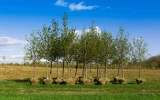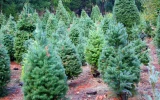How To Start a Walnut Farm from Scratch: Ultimate Guide
Are you dreaming of starting your own walnut farm? Imagine rows of stately walnut trees, their branches heavy with nutritious nuts, and the satisfaction of nurturing these trees from saplings to harvest. Walnuts, known for their healthy fats, fiber, vitamins, and minerals, make for a great choice if you're looking to grow something with both health and commercial benefits.
Starting a walnut farm is a long-term commitment, requiring up to 30 years for peak production, selecting land with a specific soil depth, and managing biennial bearing cycles. Employ high-tech methods like drone monitoring to enhance yield and sustainability in this advanced agriculture venture.
From selecting the perfect land with fertile soil to understanding the nuances of different walnut tree varieties, we cover every step in this comprehensive guide.
Summary
- The initial cost to start a walnut tree farm is around $126,500. On each acre, you can plant about 20-30 walnut trees.
- Choose land with deep, well-drained soils, and avoid areas with frost pockets or standing water.
- The profit potential per hectare of walnut trees ranges from $58,200 to $318,819.

On this page:
| Starting A Walnut Tree Farm | Quick Facts |
|---|---|
| Startup cost | $126,500 |
| Walnut trees per acre | 20–30 trees |
| English walnuts maturity | 6–10 years |
| Black walnuts maturity | 15 years |
| Peak production | At 30 years |
| Mature walnut trees production | 50–80 lbs per year after 8 years |
| English walnut trees lifespan | 150–200 years |
| Black walnut trees lifespan | 120–250 years |
| English walnuts yield per acre | 7,000–8,000 lbs |
| Black walnuts yield per acre | 1,000–2,000 lbs |
| Profit potential per hectare | $58,200 to $318,819 |
Plan and Research
Select the right land, design an effective layout, and create a solid business plan for your farm.
From the different types of walnut trees, choose varieties best suited to your climate and soil conditions. The three main types of walnut trees grown commercially are English walnuts, Black walnuts, and White walnuts. Each has slightly different characteristics in terms of hardiness, yield, and nut taste.
You'll also need to determine how many walnut trees to plant per acre to maximize yields over time. Walnut orchards are typically planted at densities ranging from 50 to over 100 trees per acre.
It's important to understand that walnut trees do not produce nuts every year due to their biennial bearing cycle.
Land selection
Look for land with deep, well-drained soils that are fertile and have a slight slope for proper drainage. Avoid frost pockets and areas prone to standing water. As walnuts thrive in deep soil, a minimum depth of five feet without obstructions is recommended.
Design and layout
Create clear sections for the walnut trees, considering their mature size for adequate spacing. Establish accessible paths for equipment and irrigation systems.
Farm business planning
A comprehensive business plan should include cost analyses for land acquisition, tree planting, and ongoing maintenance. Anticipate the initial capital needed as well as operating expenses before the walnut trees become productive. Include projections for income considering current walnut market rates and potential yield per acre.
When you plan and research for your walnut farm, consider projected prices and demand. Here's our article about it.
As you develop your business plan, it's also critical to consider the typical lifespan of walnut trees so you can plan for long-term maintenance and tree replacement. Older trees have lower yields, so commercial orchards are typically replanted at around 25-30 years.

Prepare the Land
For a successful walnut orchard, the quality of the soil, consistent water supply, and effective management of pests and diseases are fundamental to maximizing the average yield per acre.
Soil preparation
Your first task is to create a fertile foundation. Start by clearing the land of debris, rocks, and weeds. Soil testing is essential; it informs you about nutrient deficiencies and pH levels. Once you know what your soil lacks, amending it with organic matter or minerals can correct any imbalance. Tilling the soil to a fine-grained tilth enhances root penetration and water retention.
Irrigation systems
Walnuts require a reliable source of water, particularly in dry climates. Drip or micro-sprinkler irrigation systems are effective options that conserve water and reduce the spread of diseases by minimizing water contact with the leaves. Ensure you design the system to evenly distribute water across your land, reaching the root zones of every tree.
Pest and disease control
Establish a monitoring program to quickly identify and control any potential issues before they spread. Your strategy may involve cultural practices, chemical applications, or a combination of both.
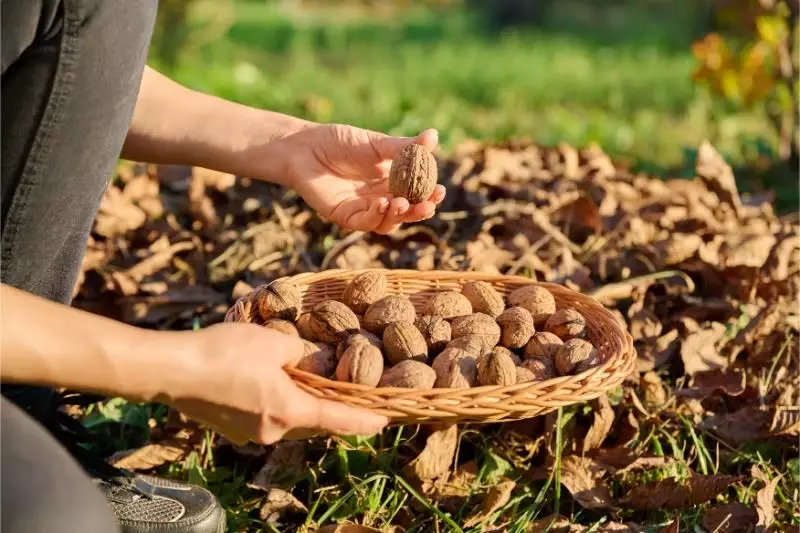
Plant the Walnut Trees
The process begins with selecting the right seedlings, understanding proper planting techniques, and ensuring early tree care for the health and productivity of your walnut trees.
Choosing seedlings
It's crucial to start with high-quality seedlings that are suitable for your climate and soil conditions. Walnut trees that have been grafted are often preferred, as they tend to produce nuts sooner and are generally more reliable in their yield.
When selecting seedlings, consider disease resistance and the potential for consistent nut yields every year, which is important for the economic viability of your walnut farm.
Planting techniques
Plant your walnut trees during the dormant season, ideally in late fall or early winter, when the trees are least active. Ensure you dig holes that are wide enough to accommodate the root spread and plant the trees at the correct depth—neither too deep nor too shallow.
For walnut trees, planting depth is crucial as it impacts the tree's access to nutrients and water, as well as its stability. Proper spacing is also essential; walnut trees require plenty of space to grow and develop a healthy canopy, which is why they should be spaced 12–17 feet apart to ensure adequate sunlight and airflow between them.
Early tree care
During the initial years, it's vital to provide your trees with the necessary support to thrive. This includes regular watering, especially during dry spells, and mulching to retain soil moisture and regulate temperature. The trees' nutritional needs should be met with appropriate fertilization, following soil test recommendations.
Furthermore, understanding the biennial bearing habit of walnut trees can help you manage care practices to avoid off-year drops in production. Protect your young trees from pests, diseases, and wildlife that could potentially harm them during their formative years.

Ongoing Maintenance
Consistent pruning, proper fertilization, and water management play a critical role in the longevity and yield of your walnut orchard.
Pruning
You'll want to remove dead or diseased wood, thin out crowded areas to facilitate light penetration and air circulation, and shape the tree to allow for easier harvesting. Annually prune your trees, keeping in mind that walnut trees are known for their impressive lifespan.
Fertilization
To replenish nutrients and boost your trees' health, apply fertilizer with the correct balance of nitrogen, phosphorus, and potassium. Conduct soil tests periodically to understand your soil's needs, and remember that the nutritional requirements can change as your walnut trees grow and mature.
- Nitrogen: Essential for leaf and branch growth
- Phosphorus: Supports root development
- Potassium: Improves overall tree vitality
Water management
Implementing an effective irrigation system helps manage moisture levels, especially during dry spells. Young trees require regular watering until they establish deep roots, while mature trees benefit from a deep watering strategy to enhance their yield.
It's important to balance your irrigation schedule to avoid water stress or oversaturation, as both can adversely affect the health and productivity of your walnut trees.
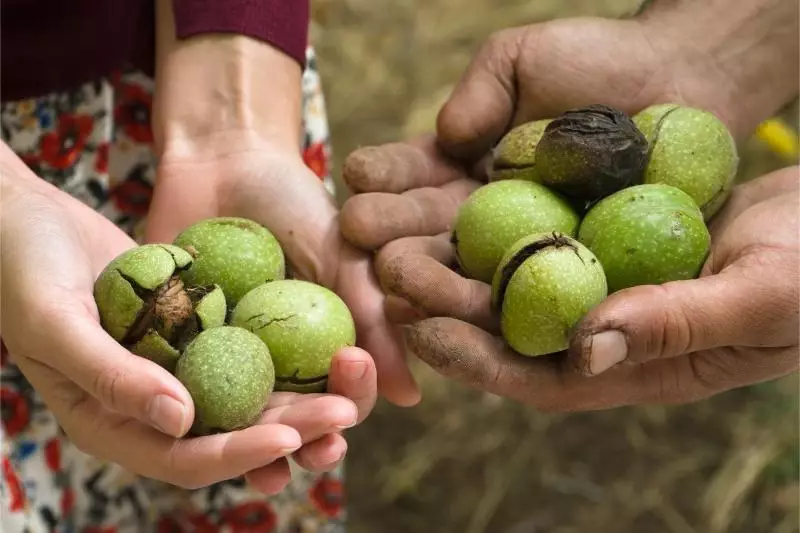
Understanding when walnut trees fruit and how often they produce nuts will aid in realistic harvest planning.
Harvest and Process Walnuts
In your quest to establish a successful walnut farm from scratch, mastering the art of walnut harvesting becomes a critical piece of the puzzle, seamlessly connecting the initial steps of setting up your orchard to the eventual harvest.
Successfully harvesting and processing your walnuts will determine the overall quality and marketability of your product. Precision in each step is crucial to ensuring that walnuts reach your customers in the best possible condition.
Walnut yield per acre
Mature walnut orchards usually yield 2,000 to 4,000 pounds per acre. Yield depends on tree spacing, cultivar, climate, and orchard management practices. Higher density planting and irrigation tend to increase yields.
As you start a walnut farm from scratch, considering the specific profit per acre of Chandler walnuts will be essential in planning your farm's layout and financial projections, ensuring you choose the most profitable walnut variety for your land.
When your orchard is established, maintaining optimal tree density, selecting high-yielding varieties, and implementing best irrigation and pruning practices can increase your average walnut yields per acre and per tree.
Walnut yield per tree
Average yields for mature walnut trees are about 50 pounds of in-shell nuts per tree. Actual yield varies based on cultivar, tree age, pruning practices, climate, and orchard management. The highest producing varieties can yield over 75 pounds per tree.
Walnut yield per hectare
Walnut orchards usually produce between 2 and 4 metric tons of nuts per hectare. Yields are highest with irrigated, high density orchards and newer varieties. Black walnuts yield less than English walnuts. Profit per hectare also depends on nut prices and production costs.
Harvesting techniques
Your walnut harvesting should begin when the kernels are light in color and begin to detach from the shells, typically from early September to early November. You can encourage the nuts to fall by gently shaking the branches or by waiting for a helping hand from nature, mainly the wind.
Once on the ground, collect the walnuts promptly to minimize the risk of mold or pests, using tools like a Nut Wizard to expedite the process. The timing of your harvest is as important as the method you choose.
Walnut drying
After collecting your walnuts, remove the green hulls. The nuts need to be dried to a moisture content of about 8% to prevent spoilage, which can be achieved in well-ventilated areas or with the use of gas dryers, typically for less than 24 hours. Properly dried nuts crack better, leading to higher yields of whole kernels. Drying procedures are critical; they must be closely monitored to ensure quality.
Storage and packaging
Once dried, your walnuts should be stored in a cool, dry place until you're ready to crack, grade, and package them for sale. In-shell walnuts can be sold directly, or you may choose to shell them, increasing their value but also the effort required.
Ensure that your packaging is sealed and protects the kernels from light and air to maintain freshness. Consider investing in high-quality packaging materials to extend the shelf life of your walnut products.
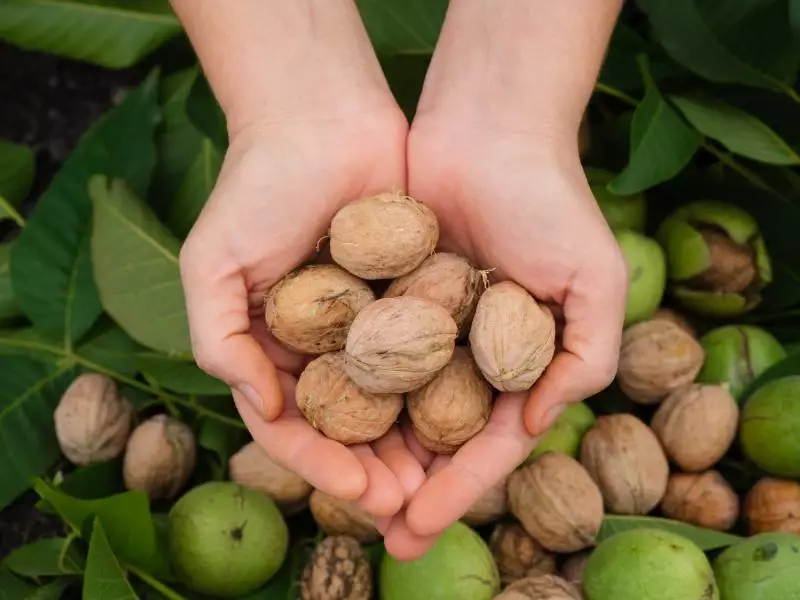
Market Your Walnuts
Successfully marketing your walnuts hinges on recognizing demand, showcasing your product's best qualities, and ensuring they reach your customers effectively. Each aspect plays a vital role in captivating your audience and converting interest into sales.
Is walnut farming profitable?
The profit potential of walnut orchards depend on inputs, yield, nut price, and water availability. Well-run orchards can generate over $2,500 per acre in profit after expenses. There are significant upfront investments, and water is a key cost factor.
As you start a walnut farm from scratch, understanding the profitability of nut tree farming per acre, especially for walnut varieties, is crucial to effectively plan and maximize the financial success of your farm.
For quicker nut production and profits, focus on the fastest growing walnut species adapted to your area. In good conditions, they can grow over 3 feet per year when young. Fast early growth allows earlier nut production.
Understanding the market
Knowledge of pricing can guide your decisions on when to sell and how to position your walnut products. Pay attention to global supply and demand, as these factors directly influence profitability.
Branding and packaging
Elegant and secure packaging not only protects the quality of your walnuts but also serves as a silent salesman, visually communicating your brand's essence. The way your product looks on the shelf can be just as important as the quality inside.
Sales and distribution channels
Explore various options—local farmers' markets, online stores, and wholesale to retailers—and consider which align with your brand and reach your intended market. Diversification can help stabilize revenue streams and increase the resilience of your business model.
Scale Your Business
Scaling your business involves leveraging technology, diversifying your offerings, and incorporating sustainable practices to ensure long-term growth.
Investment in technology
Modern agricultural technology might include advanced irrigation systems for efficient water use or drone technology for monitoring crop health. By implementing precision farming tools, you can enhance yield rates and reduce resource waste.
Diversification strategies
One approach in diversifying your revenue streams could be to introduce new walnut varieties that cater to different market segments. Additionally, branching out into walnut-based products like oils or spreads could open up new markets and stabilize your income throughout the year.
Sustainability practices
Focus on methods like organic farming, soil conservation, and renewable energy sources. These practices can lead to certifications that may allow for premium pricing on your walnuts.
Can You Make Money From Black Walnut Trees?
Growing black walnut trees can be highly profitable, especially if you focus on improved cultivars with thinner shells and larger nutmeats. These cultivars can be up to five times more profitable than wild-grown types.
A large 50-foot black walnut tree can be worth between $10,000 and $30,000, depending on various factors like size, age, and wood quality. Trees with a diameter of 20 inches can be valued between $700 and $800.
The value of black walnut trees increases with age. For instance, a 30-year-old tree may be worth around $500–$2,500, a 50-year-old tree between $800 and $8,500, and a 100-year-old tree up to $5,000–$55,000.
Starting a black walnut farm
If you want to start your own black walnut farm, you'll need to know the common problems with black walnut trees so you can plan accordingly.
Below are other things you'll also want to learn about growing black walnuts:
- The typical growth rate of black walnut trees
- Cultivating your black walnut crop for maximum profits
- Where to sell your walnuts whether that be directly to consumers, retailers, or processors.
- The potential worth of an acre of mature black walnut trees
Tree density and maturity of black walnuts
As your trees mature, maintaining the right tree density will impact both current and long-term yields and land value. Here's the average number of black walnut trees typically planted per acre to guide your initial spacing.
You'll also want to understand how many years it takes black walnut trees to reach maturity so you have a sense of when your orchard investment will begin generating nut revenues.


